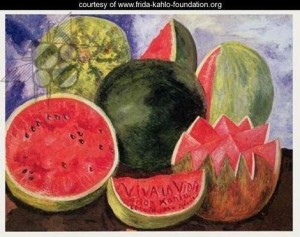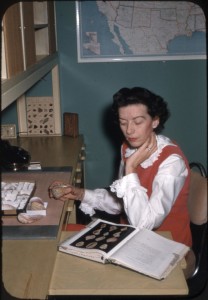Kahlo, Rivera, Kingsolver

The current exhibit of artworks by Frida Kahlo and Diego Rivera at Nova Southeastern University Museum in Fort Lauderdale reminded me of visiting their house in Coyoacán, Mexico (Sister-City of Arlington VA) in 1996 with Lilli, Shelby and Carol Starr. I had seen their works in museums and in pictures, but knew little of their history. The video featured in this exhibit made me appreciate more fully the genius of these two artists and the impact they had, not only on each other, but also on other artists to the present day.
My favorite painting in the exhibit was the one (above) labeled “Viva la Vida,” which I would translate as “live con brio!” Several of these paintings by Kahlo and Rivera were in the exhibit, but two very familiar to me were not: a drawing of a shoe seller by Rivera that Harry gave me and a print of Rivera’s Posada (a traditional Christmas Eve procession) that I brought back from our ’96 trip for my Children’s Choir at Cherrydale UMC. News flash, May 10, 2015: the New York Times ran an article today entitled “Frida Kahlo Is Having a Moment,” which mentions the exhibit I saw in Fort Lauderdale. You saw it here first!

My friend Marjo lived in Mexico City as a pre-schooler, while her father worked as an engineer for Pemex (on loan from the Phillips Petroleum Company). She tells me that her mother, Lilburn Hettick, once met Diego Rivera. Lilburn, with her collections of shells and Mexican artifacts, was an important influence in my life. Her curiosity and her enthusiasm for learning from her travels continues to inspire me. I know she is smiling down on the road trips Marjo and I take each spring.
The Kahlo-Rivera household in Coyoacán had a powerful influence on the novelist, Barbara Kingsolver. Her 2009 novel, The Lacuna, draws convincing portraits of Kahlo and Rivera through the eyes of a cook and typist she names Harrison Shepherd. When Frida and Diego extend hospitality to Lev and Natalya Trotsky, exiles from Stalin’s Russia, Shepherd becomes Trotsky’s secretary. Early on, the novel includes a colorful account of the floating gardens of Xochimilco, which Lilburn told me about, but I’ve never seen. Later, Kingsolver gives a dramatic, but disturbing account of how working for Trotsky affected Shepherd’s life after he settled in Asheville NC. The Lacuna is an absorbing, thought-provoking portrayal of the US and Mexico from 1929 – 1954 that combines art, cooking, politics, literature, strong women, and exemplary writing–my kind of book!
Carol Starr, who studied in Mexico City as a high school student and speaks Spanish fluently, was our guide in the 1996 trip from Mexico City to Palenque to Chiapas. In February she and I heard a speech by Alejandro Estivill, Deputy Chief of Mission for the Mexican Embassy in Washington. In March she traveled to the state of Michoacán with a group of students in the Cross Cultural Film Production Course of American University and Tec de Monterrey. The resulting documentary, The Monarch Butterfly Effect, premieres April 28 at the Mexican Cultural Institute in Washington. Here is a trailer.
Perhaps it’s no coincidence that Barbara Kingsolver found the amazing migration of the monarch butterfly inspiring and imagined these fragile creatures relocating themselves, in response to changing weather patterns, from Michoacán to the southern Appalachians of North Carolina. That is the setting of her 2012 book, Flight Behavior, appreciatively reviewed here in the New York Times Book Review. That book failed to grab me the way The Lacuna did; I should give it another chance.
Back to Alejandro Estivill. I asked him what books he would recommend for those of us wanting to more about present day Mexico. His response:
- Mañana Forever? Jorge G. Castañeda, 2011
- The Bear and the Porcupine: the U.S. and Mexico, Jeffrey Davidow, 2007
- The Labyrinth of Solitude and Other Writings, Octavio Paz, 1994
Leave a Reply